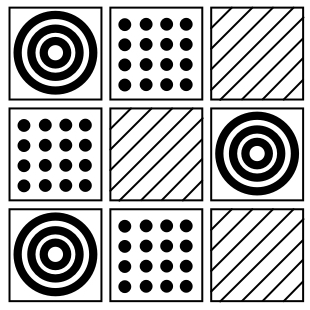Copyright © University of Cambridge. All rights reserved.
'Three Way Mix Up' printed from https://nrich.maths.org/
Show menu
Why do this problem?
This activity allows pupils to explore in a non-threatening 'game-type' way, and begin to talk about what they are doing.
Possible approach
Start off with some tiles in a line and ask the children to talk in pairs about what they see. Invite them to share their observations - this may result in them counting the ones that are the same colour and talking about those numbers. Encourage them to use vocabulary such as 'more than', 'less than', 'same as', 'to the right of', 'to the left of', 'next to' etc.
Then move on to the three by three arrangement and ask them what they notice now. As they share their thoughts, you may need to introduce new vocabulary such as 'rows' and 'columns'. Set up the challenge as stated and ask learners to work in pairs. It would be good to have a space on the wall or the board for a pair to add a new solution once they have found one.
Bring the children together to look at all the solutions they have found so far. At this point, some may notice that in fact they are not all different and there may be some discussion needed as to what 'same' and 'different' mean in this context. Do rotations count as the same?
You may like to keep this as a 'simmering' activity over a number of weeks, then come back to it. How do the children know that they have found all the different arrangements? Did anyone have a good way of finding them all?
Key questions
What coloured tiles have you got here?
Have you checked it to see if it obeys the rule?
How do you know your arrangement is different from the others you've made?
Possible extension
Look at using different rectangles rather than a square arrangement.
Possible support
For youngsters who have difficulty discerning colours, this alternative may be useful:
(The file for this alternative black and white version can be found here.)
Help may be necessary for some by way of an adult to assist the pupil with focusing on both the columns and the rows. Having counters to move around or a three by three grid to colour will also help.
